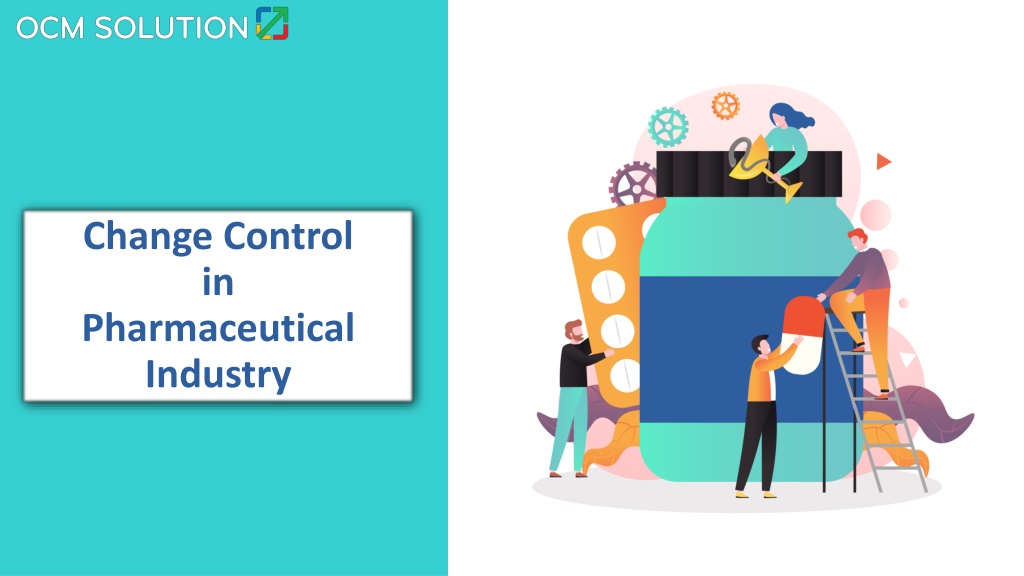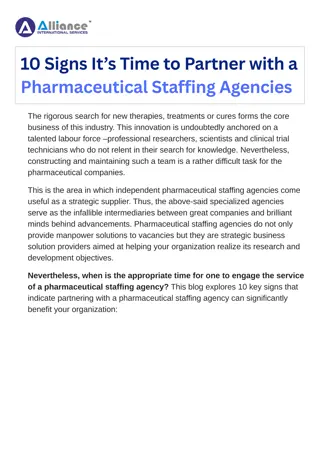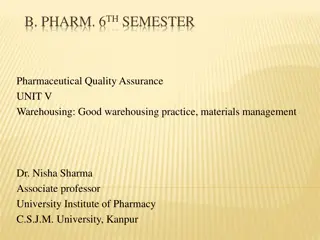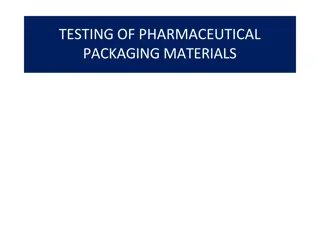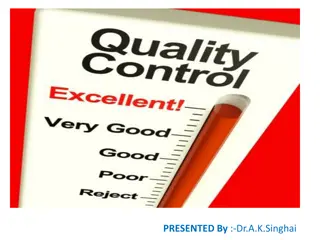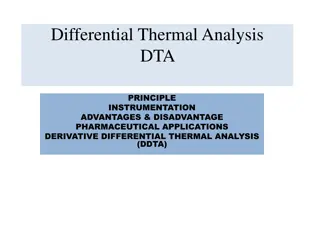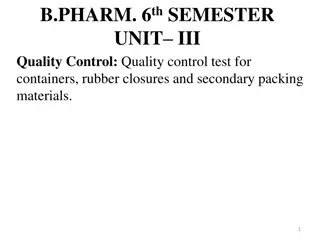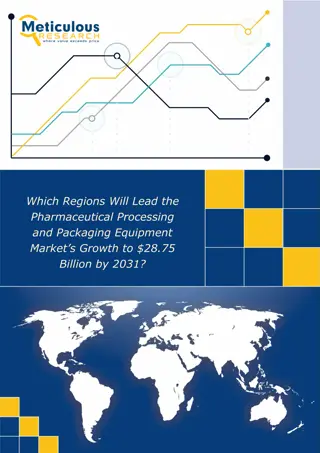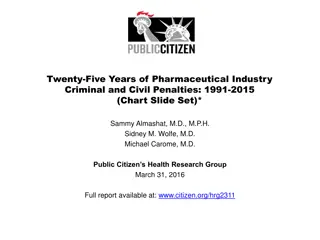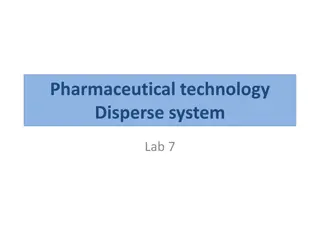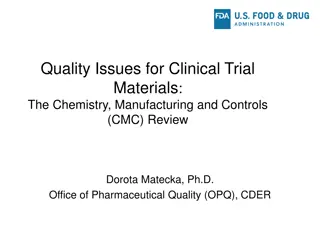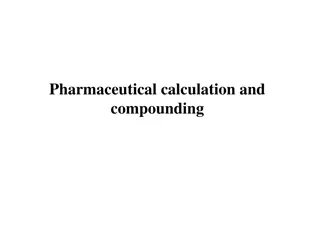Change Control in Pharmaceutical Industry
Change control in the pharmaceutical industry is a critical process that ensures the management of alterations to maintain product quality and compliance with regulatory standards. It involves categorizing changes as minor, major, or critical, each requiring specific handling to minimize risks and uphold product integrity. The process includes identification, justification, and assessment of stakeholder impact to streamline change management in the pharmaceutical sector effectively.
- Pharmaceutical industry
- Change control
- Quality management
- Regulatory compliance
- Process modification
Download Presentation

Please find below an Image/Link to download the presentation.
The content on the website is provided AS IS for your information and personal use only. It may not be sold, licensed, or shared on other websites without obtaining consent from the author. Download presentation by click this link. If you encounter any issues during the download, it is possible that the publisher has removed the file from their server.
E N D
Presentation Transcript
Change Control in Pharmaceutical Industry
What is Change Control in Pharma? Change control in pharma is a thorough approach to managing all alterations that might influence the pharmaceutical product's quality. Change control in pharma is a critical component of quality management systems, aiming to mitigate risks associated with changes while ensuring compliance with regulatory standards. Change control in pharmaceutical industry refers to a systematic approach to manage and document any modifications to established processes, systems, or products. This ensures the consistent production of high-quality medicinal products, even in the face of alterations.
Types of Change Control in Pharma 1. Minor Change Low impact on quality, efficacy, safety. Often administrative or procedural. Requires documentation for transparency. Through the implementation of these types of change control in pharma, and with the guidelines dictating change control pharmaceutical industry, manufacturers maintain a dynamic yet controlled environment, ensuring that every product meets the highest standards. 2. Major Change Moderate to high impact on product characteristics. Examples: Changing raw material suppliers, adjusting formulation. Requires thorough review, validation, and possibly regulatory communication. 3. Critical Change Profound impact on drug's quality, safety, efficacy. Examples: Overhaul of production process, new tech, significant ingredient modification. Demands exhaustive testing, validation, and regulatory approval.
1. Identification of Change The change control process in pharma begins when a change is proposed. The reasons for change initiation in the pharmaceutical sector can be multifaceted, and identifying the exact nature and reason for the change is crucial for proper change management in pharmaceutical industry. Reasons for change can include: Equipment/facility upgrades Changes in raw materials or suppliers Process modifications Regulatory requirements Identification is not merely about recognizing that a change is necessary, but understanding the 'why' behind it, and gauging the potential impact it may have. During the identification phase of the change control procedure in pharma, it's vital to document: Reasons for change Potential scope Preliminary assessments or observations. This documentation not only provides clarity for the team involved but also serves as a record for future audits or reviews.
2. Justification for Change The justification step is a pivotal checkpoint in the change control process in pharma. Just as it's imperative to identify a potential change, it's equally crucial to provide a compelling reason for implementing it. Hour 1 4. Stakeholder Impact Address effects on production teams, quality control, regulatory bodies, and consumers. 1. Purpose & Objective Define clear purpose. Objectives can include efficiency, safety, compliance, product quality, and addressing challenges. Main Dashboard & Toolkits Overview The Change Management Workflow Starting Projects Templates & Reports Adding Team Members Customization Importing & Exporting This phase ensures that changes are well-thought-out, beneficial, and in alignment with both immediate needs and long-term goals. 5. Strategic Alignment Ensure fit with organizational goals. 2. Risk vs. Benefit Weigh pros and cons. Consider cost, quality, downtime. 6. Evidence/Data Use research, benchmarking, stakeholder feedback, and other empirical evidence. 3. Resource Assessment Evaluate manpower, finances, time, expertise, etc. 7. Regulatory Considerations Check compliance implications.
3. Preliminary Assessment/Review The preliminary assessment or review serves as the initial screening phase in the change control pharmaceutical process. While the earlier steps focused on identification and justification, this phase is centered around understanding the potential breadth and depth of the change's implications. Hour 1 4. Scope of Change Address effects on production teams, quality control, regulatory bodies, and consumers. 1. Immediate Impacts Assess direct effects on product quality. Ex. Change in raw material affects formulation. Main Dashboard & Toolkits Overview The Change Management Workflow Starting Projects Templates & Reports Adding Team Members Customization Importing & Exporting This phase acts as a filter, ensuring judicious allocation, product quality, and compliance 5. Need for Further Analysis Ensure fit with organizational goals. 2. Regulatory Implications Check for regulatory standards or need for approvals. 6. Stakeholder Involvement Use research, benchmarking, stakeholder feedback, and other empirical evidence. 3. Potential Risks Identify immediate and underlying risks. Ex. New machine risks: efficiency, safety, contamination. 7. Documentation Check compliance implications.
4. Detailed Evaluation If the change is approved for further consideration, a detailed evaluation is performed. This step of the change control pharmaceutical process includes: 1. Determining the impact on the product's quality, safety, and efficacy Quality: Check stability and potency. Safety: Identify risks like contamination. Efficacy: Ensure therapeutic effect remains. Hour 1 Detailed Evaluation ensures that any proposed change doesn't compromise the product's safety, efficacy, or quality, aligns with regulations, and is efficiently managed in terms of resources and time. Main Dashboard & Toolkits Overview The Change Management Workflow Starting Projects Templates & Reports Adding Team Members Customization Importing & Exporting 2. Reviewing the effect on current validation status Does change affect validation? Consider equipment calibration and method validation. 3. Assessing Potential Regulatory Implications Reporting: Any new reports needed? Compliance: Ensure alignment with regulations. 4. Evaluating the Necessary Resources & Timeframe Estimate manpower, costs, technical needs. Set a realistic timeline.
5. Approval or Rejection Based on the detailed evaluation, the change may be approved or rejected. This decision is usually made by a change control board (CCB) or committee comprising: quality assurance, manufacturing, engineering, regulatory affairs, and other relevant departments. Here's a brief overview of this phase: Hour 1 1. Key Decision Factors: Safety & Efficacy: Ensure no compromise to product's therapeutic effects. Regulatory Alignment: Ensure full compliance with industry standards. Feasibility: Assess if change is achievable with available resources and without operational disruption. The approval phase in pharma change control evaluates proposed changes leading to an informed decision by the Change Control Board. Main Dashboard & Toolkits Overview The Change Management Workflow Starting Projects Templates & Reports Adding Team Members Customization Importing & Exporting 2. Documentation & Feedback Every decision is documented, including reasons and conditions. Feedback provided, especially for rejected proposals, highlighting areas of improvement. 3. Communication: Decision shared organization-wide ensuring alignment across departments.
6. Communication Throughout the process, effective communication is essential in change control pharmaceutical process. Stakeholders, including those in production, quality control, and regulatory affairs, must be informed of the change and its implications. 1. Broad Awareness Unified understanding across departments: R&D to manufacturing. Hour 1 2. Feedback Mechanism Channels for teams to voice insights and concerns. Main Dashboard & Toolkits Overview The Change Management Workflow Starting Projects Templates & Reports Adding Team Members Customization Importing & Exporting By ensuring clear communication, you can smoothly navigate changes, minimizing errors and maintaining product integrity. 3. Stakeholder Engagement Inform key parties like suppliers if their roles are affected. 4. Regulatory Notification Communicate major changes to authorities for compliance. 5. Documentation Record communications for transparency and audits.
7. Implementation When a change is approved, the implementation phase of the change control pharmaceutical process comes into play. Properly executing this stage is crucial for ensuring the integrity of the change and maintaining the standards that the pharmaceutical industry demands. In the pharmaceutical realm, the implementation of any approved change must adhere to strict protocols: Hour 1 1. Detailed Plan Strategize using the change control SOP. Incorporate re-validation if required. The precise implementation of changes, guided by established change control SOP, upholds the stringent standards of the pharmaceutical sector. Main Dashboard & Toolkits Overview The Change Management Workflow Starting Projects Templates & Reports Adding Team Members Customization Importing & Exporting 2. Document Updates Revise affected SOPs, batch records. Utilize SOP templates for consistency. 3. Execution Critical step guided by SOP.
8. Verification After the change has been implemented, it's crucial to verify that it was executed correctly and that there are no unintended consequences. This step of the change control pharmaceutical procedure might involve: 1. Testing Specific tests, possibly both qualitative and quantitative, are carried out to confirm that the change meets its intended objectives and that no detrimental effects on product quality or process efficiency have occurred. Hour 1 Through these verification activities, the pharmaceutical entity ensures that the change not only meets its intended purpose but also maintains the integrity of the product and process. Main Dashboard & Toolkits Overview The Change Management Workflow Starting Projects Templates & Reports Adding Team Members Customization Importing & Exporting 2. Inspections Physical inspections may be necessary, especially when the change involves equipment, facilities, or tangible materials. This helps in ensuring that installations or modifications adhere to standards and specifications. 3. Audits An audit, which can be internal or external, reviews the documentation, processes, and outcomes related to the change. It ensures that the implementation aligns with the change control SOP, regulatory requirements, and industry best practices.
9. Closure and Review The final step in the change control process is to formally conclude the initiative and reflect upon its long-term implications: 1. Formal Closure After ensuring the change has been successfully implemented, verified, and all necessary documentation is in place, the change control request can be formally closed in the system or registry. Hour 1 Through these verification activities, the pharmaceutical entity ensures that the change not only meets its intended purpose but also maintains the integrity of the product and process. 2. Post-implementation Review Main Dashboard & Toolkits Overview The Change Management Workflow Starting Projects Templates & Reports Adding Team Members Customization Importing & Exporting Even after the change is finalized, periodic assessments are vital. These reviews monitor the change's sustained effectiveness, ensuring it continues to meet the desired objectives without introducing unforeseen issues. 3. Feedback Collection Gathering feedback from various departments and stakeholders provides insights into the change's real-world impact, offering valuable lessons for future change control initiatives. a 4. Continuous Improvement The insights from these reviews feed into a cycle of continuous improvement, enabling better handling of subsequent changes and refining the change control process itself.
AGS Want to Learn More? Visit: OCMSolution.com
